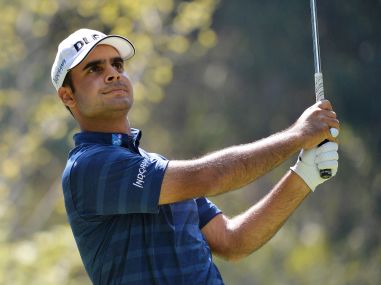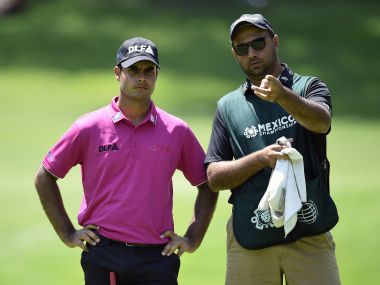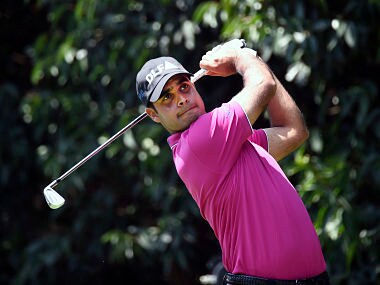One unforgettable memory of Wellington Gymkhana, Coonor seemed straight out of a James Bond movie scene! We had just driven past massive bisons along winding roads on a cold, slightly misty morning when a noisy helicopter descended from the skies just a couple of hundred feet ahead.
It was a surreal scene. The mist-laden hills formed the perfect backdrop as the helicopter was gradually settled on the first fairway of the golf course even as we gawked open-mouthed. Now all that it required was for someone to emerge from it with a golf bag in hand.
Of course nothing so dramatic happened. It was just an army bloke getting off the copter and going about his errands. But that scene on Coonor’s challenging golf course that we often referred to as “commando course” remained etched in memory.

Shubhankar Sharma in action during the final round of the WGC Mexico Championship. Reuters
Wellington Gymkhana is managed by a committee of armed forces personnel and civilians. However, this is only one of around 160 courses owned by the military. These Army-Navy-Air Force-BSF owned courses account for 60 percent of all golf courses in India. Of late, these are not called golf courses but are designated as ‘Ecological Park and Training Areas’.
The nomenclature of the courses notwithstanding, what has really caught the imagination of the golfing world these last four days are the awesome exploits of 21-year-old ‘army brat’ Shubhankar Sharma. He displayed remarkable temperament and skill on the first three days of the WGC Mexico Championship to take the game by storm. Tellingly, it was on his PGA debut.
Shubhankar forcefully drove home the point that Indians could be a force to reckon with in this Olympic sport provided available infrastructure and other resources were put to optimum use.
Sure, Shubhankar is not the first army kid to compete at international level. Before his older friend Anirban Lahiri and he came on to the PGA Tour, others, Jyoti Randhawa and Digvijay Singh to mention two, had already made a mark on Asian and European Tours. But the young debutant Shubhankar with his impressive heading of the leaderboard in two successive rounds against the cream of PGA golfers made the world sit up and take note.
On Sunday, the last day, the Chandigarh professional might have been weighed down by expectations and the pressure of playing alongside crowd favourite and iconic golfer Phil Mickelson, who walked away with the top prize money of $1.7 million. But in the three days that he dominated the field, Shubhankar did enough to draw attention to his enormous potential to become a star of epic proportions.
At the same time his exploits showcased the Indian armed forces’ special ability to make a stirring contribution in a sport that was re-admitted into the Olympic movement in 2016.
Years ago, in an acknowledgement of the armed forces’ contribution to golf, they were designated as one of the five zones (East, West, North, South, Army) of the Indian Golf Union. Thus, like the others they too have a shot at IGU presidency, which goes by rotation.
Unfortunately, their access to mind-boggling and scenic expanse of land notwithstanding, most armed forces golf courses are not in pristine condition. They are more like parkland courses with minimum maintenance of fairways and fairly decent greens and tee-boxes. The downside of this is that the ball runs a mile, especially in the dry months and this camouflages many a golfer’s limitations.
Nevertheless the armed forces’ have a great role to play in the development of the game in India.
They posses the maximum number of golf courses and hence could have many more ‘army brats’ lurking around just waiting to be discovered and pointed in the right direction.
Of course Lahiri’s and Shubhankar’s achievements would have fired the ambitions of many army kids but they still must find the resources to further their career. This could include identifying talent, coaching, protecting, grooming and scheduling it for the right tournaments and events. These would require the services of people who are aware of the route. Lahiri and Shubhankar were fortunate that they found the right coaches and mentors at the right stage. But it might not always turn out that way.
Apart from setting up a structured system for promotion of talent, the armed forces must also throw open their golf courses for other neighbourhood kids. Of course many of the courses might be along border areas or in sensitive zones and hence it might not be possible to open them to all.
However, wherever possible, the armed forces must allow young boys and girls in their pre-teens and teenage to hone their golfing skills on their courses. It will give the game in India an incredible shot in the arm. Much like the boost Thai golf got when they opened hundreds of tourism-targeted private courses across the country.
Golf, whether boys or girls golf, is at the cusp of a revolution in India. But it needs a significant thrust. Unfortunately, golf clubs are all too few and they are under immense pressure to cater to just their existing members. The opening up of the armed forces golf courses and their promotion of young talent could be just what the game needs to undergo a paradigm shift in fortunes. Indian golf badly needs that timely boost. Will our defence forces oblige and thereby be at the forefront of throwing up many more Shubhankar Sharmas?
Published Date: Mar 05, 2018 17:35 PM | Updated Date: Mar 05, 2018 17:48 PM


